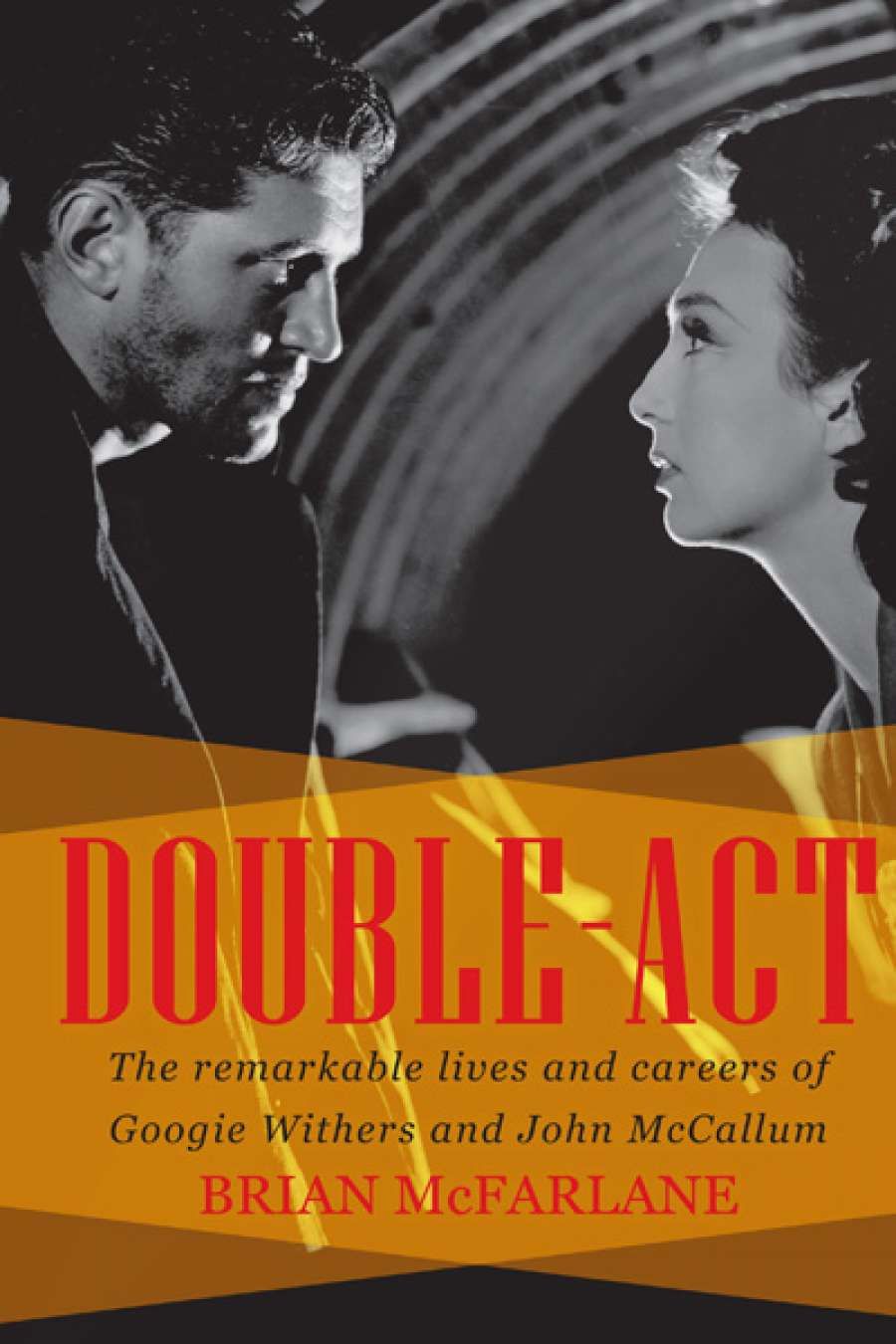
- Free Article: No
- Contents Category: Film
- Custom Article Title: Desley Deacon reviews 'Double-Act' by Brian McFarlane
- Book 1 Title: Double-Act
- Book 1 Subtitle: The remarkable lives and careers of Googie Withers and John McCallum
- Book 1 Biblio: Monash University Publishing, $39.95 pb, 259 pp, 9781922235725
Withers began her career in 1932, in the chorus of musicals. She was quickly noticed for her confident, sassy personality and good looks. When she was called in for a film test, she was so impressive that she immediately replaced the young woman cast for the part. By the time she met McCallum she was a well-established star; she had been engaged to actor Michael Wilding (who later married Elizabeth Taylor); and had a love affair with novelist Richard Llewellyn (How Green Was My Valley).
McCallum returned to England in 1936 to study at the Royal Academy of Dramatic Art. Handsome and intelligent, he was just beginning a promising West End career when the war took him back to Australia and the armed forces. After the war he set off for Hollywood via London, where the burgeoning British film industry snapped him up. In 1946, on his third film, he met his co-star, Googie Withers. The couple married in January 1948. The box office loved them together, and they co-starred in five more films over the next six years. They also found time to continue their stage careers, and both made their débuts in the new media of television. With Withers’ mother and a nanny to help, they never contemplated any break in her career when their first child, Joanna, was born in 1950.
In 1954, at the height of their popularity, the theatrical giant J.C. Williamson’s Ltd (JCW), invited them to make a tour of Australia. They were a great success, socially as well as professionally. McCallum even managed to appear in the film Smiley (1956) while he was in Sydney. At the end of their tour, Frank Tait, head of JCW, took him aside and offered him the position of joint managing director.
 John McCallum, with family, friends and famous marsupial colleague, for This Is Your Life, Australia (1976)
John McCallum, with family, friends and famous marsupial colleague, for This Is Your Life, Australia (1976)
‘this duo ... are rightly called Australian theatre royalty’
They returned to Australia permanently in 1958. Withers had just made a triumphant Shakespearean début at Stratford-on-Avon (Hamlet and Much Ado About Nothing). McCallum spent seven years as joint managing director of JCW alongside the ageing Tait. His tenure included the enormous success of My Fair Lady, the legendary Sutherland–Williamson Grand Opera Co. tour, and appearances by Marcel Marceau, Harry Belafonte, and Vivien Leigh, the latter directed by their old friend Robert Helpmann. But he resigned a year after Tait died and he had succeeded him as managing director. One reason for his resignation was the board’s veto of his plans for further film-making, following their involvement in the production of They’re a Weird Mob (1966). Over the next few years, his major achievements were in television, where he produced that Australian icon Skippy (1968–70), followed by Barrier Reef (1971–72), the first Australian series sold to a major American network, and Boney (1972–73), featuring Arthur Upfield’s half-Aboriginal detective. But his movies – forgotten today – did not catch the spirit of the Australia’s New Wave, and he returned to the theatre.
 Googie Withers and John McCallum in The Loves of Joanna Godden (1947)
Googie Withers and John McCallum in The Loves of Joanna Godden (1947)
While McCallum was steering the fortunes of Australian theatre, film, and television, Withers established herself as a favourite with the Australian public. Like many of the ‘Ten Pound Poms’ who settled in Australia in the 1950s and 1960s, she found it ‘a young, vigorous place’; and she always praised Australia as a wonderful country to bring up children. She was an actress at the top of her powers, and audiences appreciated having someone of her calibre on their stages. With the growing availability and comfort of long-distance flights, she was able, like many after her, to maintain an international career, making her Broadway début in 1961 (The Complacent Lover, with Michael Redgrave) and returning regularly to London’s West End. As she noted shrewdly, all of these ‘homecomings’ – to Australia and to England – were great for publicity.
‘While McCallum was steering the fortunes of Australian theatre, film, and television, Withers established herself as a favourite with the Australian public’
Australians also liked the Withers–McCallum double-act. Their happy family life gave their public a comfortable feeling, softening the image of McCallum the businessman with that of the loving father and husband, and turning Withers the jet-setting actress into a normal housewife and mother. Together they maintained their act on stage, film, and television until 2002, when, in their mid-eighties, they made their last appearance on stage in London, in Lady Windermere’s Fan. When McCallum died in 2010, they had been married for sixty-two years. Withers died eighteen months later.
Brian McFarlane, an expert on British and Australian cinema, has carried off his difficult task with great skill. He notes wryly that this is essentially a happy story, without any hint of scandal to add spice. Nevertheless, it is fascinating to watch how the pair achieve and maintain the delicate balancing act that is a successful theatrical marriage. McFarlane manages to provide in an entertaining manner much information that could be tedious. The many anecdotes and reports with which he fills out the personality of his two subjects have the scent of truth, rather than of the publicity desk, and convince us that the couple were, indeed, as pleasant as they are pictured. This book will provide lively – and for some nostalgic – reading for the general public and will be essential reading for historians of British and Australian theatre, film, and television.


Comments powered by CComment